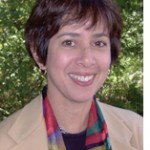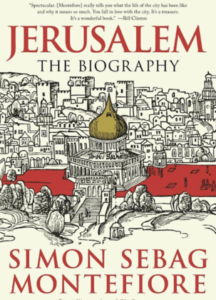By Shoshana Bryen

 WASHINGTON, D.C. — Simon Sebag-Montefiore brings impeccable credentials to the monumental task of writing Jerusalem: The Biography. A history Ph.D. from Cambridge, he has been a banker and a foreign correspondent reporting on, among other events, the fall of the Soviet Union. He is also the great-great-nephew of Sir Moses Montefiore, the international financier who was an extraordinary philanthropist, promoting education, industry, business and health services to Jewish communities in the Levant, including in Ottoman Palestine.
WASHINGTON, D.C. — Simon Sebag-Montefiore brings impeccable credentials to the monumental task of writing Jerusalem: The Biography. A history Ph.D. from Cambridge, he has been a banker and a foreign correspondent reporting on, among other events, the fall of the Soviet Union. He is also the great-great-nephew of Sir Moses Montefiore, the international financier who was an extraordinary philanthropist, promoting education, industry, business and health services to Jewish communities in the Levant, including in Ottoman Palestine.
Lineage isn’t determinative, however; mission is. Sebag-Montefiore states his. “If this book has any mission, I passionately hope that it might encourage each side to recognize and respect the ancient heritage of the Other (sic).” Any mission other than honesty in the telling of the tale is suspect.
It is also worrisome that the admission of mission doesn’t appear until the Epilogue – where perhaps it was meant as an afterthought – but it isn’t, it is fundamental. I put it here so you can enjoy the huge, gory, often-repulsive, but fascinating story of the Holy City with the knowledge that this biography serves an interest. Oddly, the mission posits only two sides, while he writes cogently and fluidly (blood being the most prevalent fluid) about so many sides that you need a spread sheet.
Sebag-Montefiore breaks the book into chapters based on sequential occupiers, noting that “It is only by chronological narrative that one avoids the temptation to see the past through the obsessions of the present.” Meaning, no doubt, the obsessions of Israelis/Jews and Palestinians – his “each side” and “the Other.” He doesn’t seem to care much what Romans, Middle Eastern Christians, Muslim conquerors, Crusaders, Mamelukes, Ottomans, Europeans (including Napoleon and the Kaiser), Albanians, or Russians think, although he draws compelling and sometimes humorous portraits of all of them.
At the end, Sebag-Montefiore is honest. Across 548 pages of text, the Jewish side of the equation never denies the Christian or Muslim heritage of Jerusalem. The “Others” not only denied the Jews the right to worship or live in the city or live at all, they denied one another. Each conqueror claimed sole occupancy – sometimes permitting others to live or pray in the city, but only as a magnanimous gesture, never by right.
The book thematically splits into those who want to live in Jerusalem and those who want to own it. The first would be the Jews, who are rarely seen between pages 135 and 391, except as parts of piles of corpses – there are a lot of piles of corpses. The second would be everyone but the Jews – a series of mainly-religious armies wanting the holy spaces for themselves – and wanting them without interference by other mainly-religious armies. The point was to have it. And to throw others out.
Suleiman the Magnificent, for example: “His achievements in Jerusalem were so successful that the Old City today belongs more to him than anyone else.” Roxelana (his wife) “liked to endow charitable foundations close to her husband’s projects; she commandeered a Mamluk palace to establish her foundation…that included a mosque, bakery, fifty-five room hostel and soup-kitchen for the poor. Thus, they made this, the Temple Mount and Jerusalem, their own.”
They did not; they just occupied it for a time, pushing “the Other” out of the way temporarily. “In Jerusalem where Suleiman promoted the superiority of Islam and diminished the status of the other two religions with a meticulous care that still guides the city now…. The Jews, on the other hand, mattered little.”
It is written so prettily that one might forget he’s writing about the removal of Jews from their holiest space.
In an effort to be even-handed late in the game, Sebag-Montefiore notes that in the 1980s, “raised hopes…were dashed by the intransigence of both sides, the killing of civilians, and the expansion of Jewish settlements in Jerusalem and the West Bank. In 1981, the assassination of Sadat, punishment for his flight to Jerusalem by fundamentalist was an early sign of a new power.” Not for the first time are houses built by Jews where other people don’t want those houses equated with assassination, terror, and torture. In this way, the Arab and then Palestinian desire for a Judenrein Judea and Samaria has the same legitimacy as the Jewish desire to live in the ancient Jewish spaces.
On the other hand, he acknowledges what so many won’t. “All the suburbs of Jerusalem outside the walls were new settlements built between 1860 and 1948 by Arabs as well as Jews and Europeans. The Arab areas, such as Sheikh Jarrah, are no older than the Jewish ones, and no more, or less, legitimate.”
The other big split in the book is on the question of “Palestinian nationalism.” Although the back cover calls Jerusalem “the capital of two peoples,” there is no indication anywhere inside that the Arabs – or anyone else – considered Palestine a separate governmental entity or Jerusalem belonging to anything other than the occupier of the time. In a footnote (really, it deserved more prominence!) Sebag-Montefiore writes:
The powerful Vali (governor) of the Vilayet (Province) of Damascus usually ruled Jerusalem…At other times, Jerusalem was controlled by the Vali of Sidon who ruled from Acre. Jerusalem was a small district, a Sanjak under a Sanjak Bey or Mutasallim. Yet Jerusalem’s status changed repeatedly over the next centuries, sometimes becoming an independent district. Ottoman governors ruled with the aid of the qadi (a city judge appointed in Istanbul) and the mufti (the leader appointed by the Grand Mufti of the empire, the Sheikkh al-Islam in Istanbul, who wrote fatwa judgements on religious questions) drawn from Jerusalem’s Families. The Pashas of Damascus and Sidon were rivals who sometimes fought mini-wars for control of Palestine.
What is Palestine here? He notes that in 1757, “A Bedouin sheikh…carved out a northern fiefdom, which he ruled from Acre – the only time, except for short lived rebellions, when a native Palestinian Arab ruled an extended part of Palestine.” Aside from the fact that Bedouins often do not consider themselves Palestinians, it was a tribal holding and Jerusalem was not the capital.
At the cusp of the 20th century, the positions of Jewish leadership and Arab leadership are clear:
Herzl dreamed that “if Jerusalem is ever ours, I’d clear up everything not sacred, tear down the filthy ratholes,” preserving the Old City as a heritage site like Lourdes or Mecca. “I’d build an airy comfortable properly sewered, brand new city around the Holy Places.” Herzl later decided that Jerusalem should be shared: “We shall extraterritorialize Jerusalem so that it will be long to nobody and everybody, its Holy Places the joint possession of all Believers.”
At exactly that moment, Yusulf Khalidi of the prominent Jerusalem Arab family, told the Chief Rabbi of France, his friend:
“God knows, historically it is indeed your country” but “the brute force of reality” was that “Palestine is now an integral part of the Ottoman Empire and, what is more serious, it is inhabited by other than Israelites.”
“While the letter predates the idea of a Palestinian nation… (he saw) the necessity to deny the Jewish claim to Zion, he foresaw that Jewish return, ancient and legitimate as it was, would clash with the ancient and legitimate presence of the Arabs.”
Khalidi was not talking about a Palestinian state, but an Arab requirement that Arabs, not Jews, rule.
Later:
Ben Gurion believed, like most of his fellow Zionists at this time, that a socialist Jewish state would be created without violence and without dominating or displacing the Palestinian Arabs; rather it would exist alongside them. He was sure the Jewish and Arab working classes would cooperate… it did not occur to the Zionists that most of these Arabs had no wish for the benefits of their settlement.”
In the later he makes the points:
• Post-1967, “is certainly the first time Jews have been able to worship freely there since AD 70.”
• “The PLO banned Palestinian historians from admitting there had even been a Jewish Temple in Jerusalem – and this order came from Arafat himself.”
• He mentions Moshe Dayan’s post-unification note in the Western Wall and continues with his message: “We’ve reunited the city, the capital of Israel, never to part it again. To our Arab neighbours, Israel extends the hand of peace and to all peoples of all faiths, we guarantee full freedom to worship. We’ve not come to conquer the holy places but to live with others in harmony.” This is followed by a description of Dayan at al-Aqsa where, “sitting in his socks with the sheikh of the Haram and the ulema, he explained that Jerusalem now belonged to Israel but the Waqf would control the temple Mount.”
Sebag-Montefiore, then, failed in his mission. At no time in this bloody carnival of odd, colorful, and violent personages and momentous events can the reader find “each side” recognizing and respecting the ancient heritage of “the Other.” On the other hand, he’s written a fascinating biography of a city that likely will never be peaceably be shared except under the sovereignty of the one side that isn’t exclusionary – the Jews.
The Epilogue
The book ends in 1967 with the unification of Jerusalem, but the Epilogue carries on. And in that short space, the difference between unified Jerusalem as the capital of the State of Israel and most of what came before emerges gracefully:
It is now one hour before dawn on a day in Jerusalem. The Dome of the Rock is open: Muslims are praying. The Wall is always open: the Jews are praying. The Church of the Holy Sepulchre is open: the Christians are praying in several languages. The sun is rising over Jerusalem, its rays making the light of the Herodian stones of the Wall almost snowy – just as Josephus described them two thousand years ago – and then catching the glorious gold of the Dome of the Rock that glints back at the sun. The divine esplanade where Heaven and Earth meet, where God meets man is still in a realm beyond human cartography.
*
Shoshana Bryen is the editor of inFOCUS and the Senior Director of the Jewish Policy Center. This article was reprinted from inFOCUS.